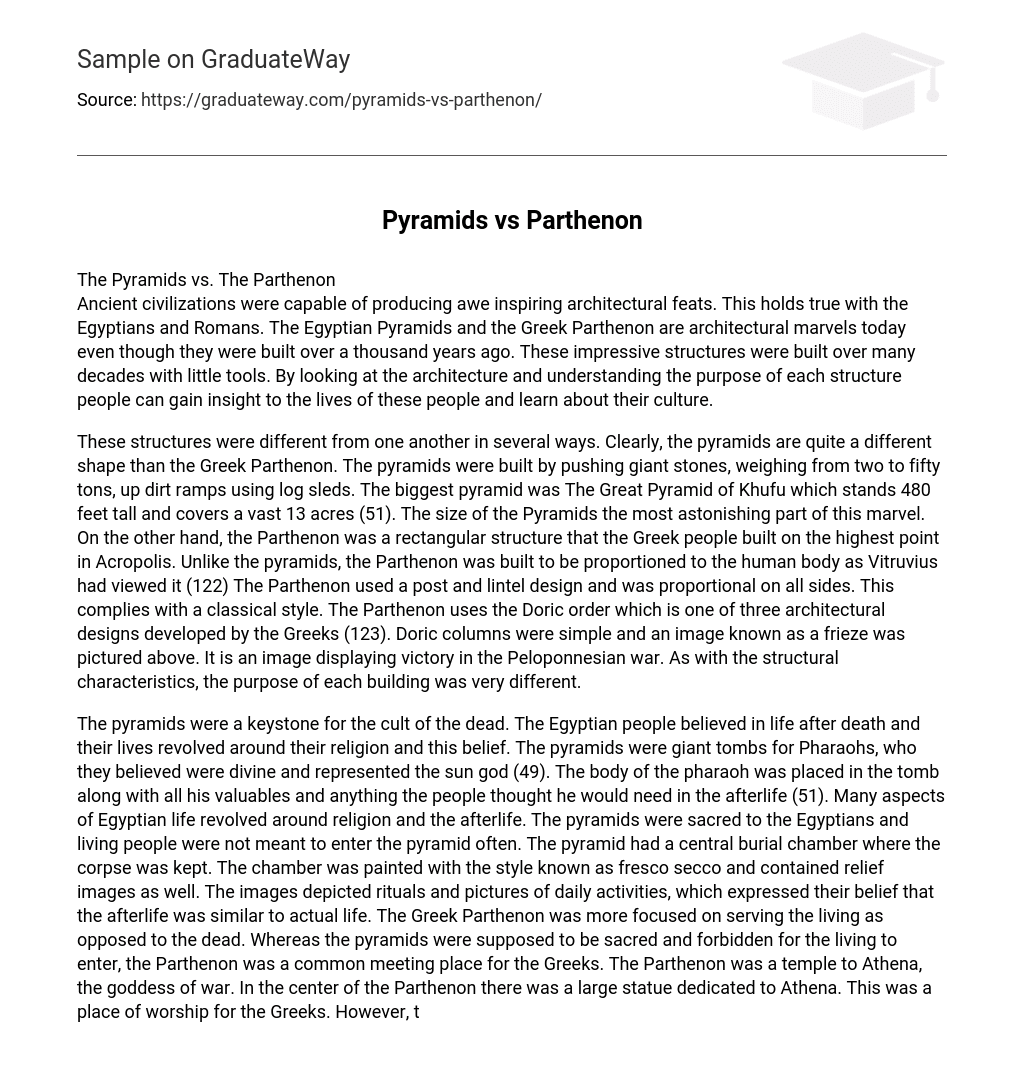The Pyramids vs. The Parthenon
Ancient civilizations were capable of producing awe inspiring architectural feats. This holds true with the Egyptians and Romans. The Egyptian Pyramids and the Greek Parthenon are architectural marvels today even though they were built over a thousand years ago. These impressive structures were built over many decades with little tools. By looking at the architecture and understanding the purpose of each structure people can gain insight to the lives of these people and learn about their culture.
These structures were different from one another in several ways. Clearly, the pyramids are quite a different shape than the Greek Parthenon. The pyramids were built by pushing giant stones, weighing from two to fifty tons, up dirt ramps using log sleds. The biggest pyramid was The Great Pyramid of Khufu which stands 480 feet tall and covers a vast 13 acres (51). The size of the Pyramids the most astonishing part of this marvel. On the other hand, the Parthenon was a rectangular structure that the Greek people built on the highest point in Acropolis. Unlike the pyramids, the Parthenon was built to be proportioned to the human body as Vitruvius had viewed it (122) The Parthenon used a post and lintel design and was proportional on all sides. This complies with a classical style. The Parthenon uses the Doric order which is one of three architectural designs developed by the Greeks (123). Doric columns were simple and an image known as a frieze was pictured above. It is an image displaying victory in the Peloponnesian war. As with the structural characteristics, the purpose of each building was very different.
The pyramids were a keystone for the cult of the dead. The Egyptian people believed in life after death and their lives revolved around their religion and this belief. The pyramids were giant tombs for Pharaohs, who they believed were divine and represented the sun god (49). The body of the pharaoh was placed in the tomb along with all his valuables and anything the people thought he would need in the afterlife (51). Many aspects of Egyptian life revolved around religion and the afterlife. The pyramids were sacred to the Egyptians and living people were not meant to enter the pyramid often. The pyramid had a central burial chamber where the corpse was kept. The chamber was painted with the style known as fresco secco and contained relief images as well. The images depicted rituals and pictures of daily activities, which expressed their belief that the afterlife was similar to actual life. The Greek Parthenon was more focused on serving the living as opposed to the dead. Whereas the pyramids were supposed to be sacred and forbidden for the living to enter, the Parthenon was a common meeting place for the Greeks. The Parthenon was a temple to Athena, the goddess of war. In the center of the Parthenon there was a large statue dedicated to Athena. This was a place of worship for the Greeks. However, the Parthenon was not only a temple but a public meeting place as well. The temple brought together religious and secular parts of the Greek culture (122). These were not separated as they were in the pyramids. Scholars also believe the Parthenon to be a victory monument (123).
The Parthenon had many uses and purposes to the Greek people. These structures give people an idea of how the civilizations lived. By looking at the Pyramids of Egypt it is easy to see that religion was very important the Egyptian people. They strained to build these amazing burial chambers for the sole purpose of preparing the pharaoh for the afterlife. It also signifies the importance and emphasis of death. The Parthenon also shows much about Greek culture. They did not put a lot of emphasis on a separate church and state because the Parthenon was both a temple and a public meeting place. This also depicts the Greeks as a highly social people. They attended public meetings, theater performances, and went to the coliseum. Even the architecture shows something about their culture. It was built on the principle of human proportion which the Greeks encountered in many daily activities. By analyzing both of these ancient architectural marvels much can be learned about their unique cultures. The Greeks and Egyptians were extremely different in their cultures and it is reflected in the buildings they left behind. The Egyptian people were determined and had a strong focus on religion while the Greeks were more social and didn’t believe in separating religion and social aspects of society. By observing the architecture and purpose of each structure it reveals more about the cultures of the Egyptians and Greeks.





